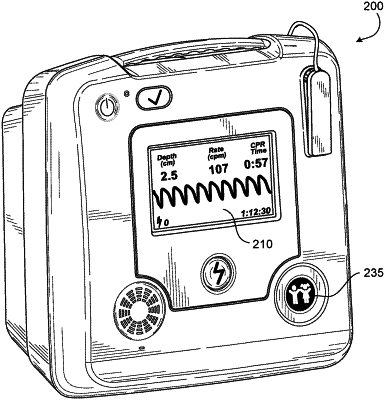| CPC A61N 1/3912 (2013.01) [A61N 1/046 (2013.01); A61N 1/39044 (2017.08); A61N 1/3925 (2013.01); A61N 1/3987 (2013.01); A61N 1/3993 (2013.01)] | 35 Claims |

|
1. A system for providing external defibrillation to adult and pediatric patients, comprising:
an automated external defibrillator (AED) comprising:
one or more capacitors for delivering a defibrillating shock to a patient;
one or more electronic ports configured to receive signals indicative of one or more sensed physiological parameters of the patient and to communicate the defibrillating shock to the patient;
a button configured to, upon being pressed, toggle between a pediatric operating mode and an adult operating mode during a resuscitation process, wherein each of the pediatric operating mode and the adult operating mode comprises a different mode-specific energy configuration;
one or more processors configured to switch the mode-specific energy configuration upon a change between the pediatric operating mode and the adult operating mode, wherein, in the pediatric operating mode, the AED is configured to deliver the defibrillating shock at a lower energy level than in the adult operating mode;
a user interface configured to:
upon a change from the adult operating mode to the pediatric operating mode, present an auditory announcement of the change from the adult operating mode to the pediatric operating mode, and
provide mode-specific treatment related guidance, comprising mode-specific chest compression related guidance, such that, when the AED is in the adult operating mode, the mode-specific treatment related guidance is suitable for treatment of an adult patient, and, when the AED is in the pediatric operating mode, the mode-specific treatment related guidance is suitable for treatment of a pediatric patient; and
an interface device configured to wirelessly transmit data to a device other than the AED.
|